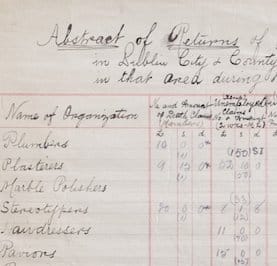Trade Unionism and the 1916 Easter Rising



This ledger sheet from the National Print Museum’s archive documents the losses sustained by Trade Unions in Dublin City & County due to ‘Military Operations’ following the 1916 Easter Rising.
On Easter Monday 1916, Padraig Pearse reads the proclamation of the Irish Republic outside the General Post Office, as armed revolutionaries claimed the main post office of a major city in the world’s most powerful empire, as their base.
In the coming days, around 2500 republicans occupy strategic positions around the city and engage in battle with 20,000 British soldiers.
Following the Revolution, many of the visionary republicans, some of whom are also labour activists and Trade Union members, face the firing squad.
Regardless of the prominence of many labour activists and union members in the Rising, the reactions of other workers was just as mixed as that of the Irish population. The British ruled Ireland for 700 years, and many young Irish men were serving in British uniforms in World War I – a factor which limited initial support for the rebellion. However, the severity of the British response, including the shelling of Dublin and the execution of the now martyr leaders, drastically changed public opinion.
The events of the 1916 Rising severely impacted Trade Unionism in the weeks and months following the uprising. As is documented from the Irish Trades Union Congress and Labour Party Conference in August 1916, the position of Trade Unionism in the city was ‘critical’:
‘Some of the more active officials had been killed or arrested, public meetings had been prohibited by proclamation, and this was held to apply also to Trade Union meetings. The dislocation of industry consequent upon the bombardment and destruction by the military of the centre of the City, led to widespread unemployment and distress, and the call upon Trade Unions for financial aid was heavy.’
Tom Johnson speaks of the members killed during the Rising:
‘Before proceeding with the business of the Congress I feel that it is my sad duty to say a word or two regarding the loss which we and the working class movement have sustained through the death of those of our comrades whose lives were sacrificed in the recent rebellion.
As a Trade Union Movement we are of varied minds on matters of history and political development, and, consequently, this is not a place to enter into a discussion as to the right or the wrong, the wisdom or the folly of the revolt, but this we may say, that those amongst the rebels who have been associated with us in the past, who have led and inspired some of us with their love of their country and their class, were led to act as they did with no selfish thought but purely with a passion for freedom and a hatred of oppression.’
Among those who died during the Rising were James Connolly, Richard O’Carroll, and Peter Mackin – three prominent men known in the Irish Labour world. James Connolly, in particular, believed that real independence for Ireland depended on the emancipation of the working class:
‘If you remove the English Army tomorrow and hoist the green flag over Dublin Castle unless you set about the organization of the Socialist Republic your efforts will be in vain. England will still rule you. She would rule you through her capitalists, through her landlords, through her financiers, through the whole array of commercial and individualist institutions she has planted in this country and watered with the tears of our mothers and the blood of our martyrs.’
The consequences of the 1916 Rising was felt by all across Irish society. In the words of the poet William Butler Yeats, ‘a terrible beauty was born’. The machine which printed ledger sheets such as this can be viewed in the National Print Museum.